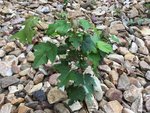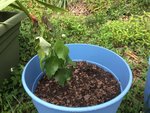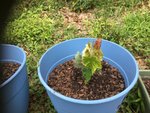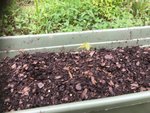Transplanting was a success, though further work is gonna have to wait until at least tomorrow as we need more perlite - and light - to keep working. Gonna break down how things went, pot-by-pot.
==STARTING POINT==
First step was to punch out drain holes in all the pots - they were all technically "self-watering" ones but had points left in explicitly for punching drain holes into. After that, we filled the three tall & round pots mentioned in an earlier post up about 10-15% with Perlite, and about 60-65% on top with Miracle Gro soil, leaving the rest of the space empty. Later did more or less the same for a long pot.
==THE TALL UPRIGHT SEEDLING==
This was our first one, and we started by moving the rocks away from its trunk to get a better look at things.
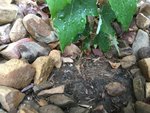
The roots had both merged with & in some places poked down past the ground cloth that the river rock was on top of, so careful application of a multi-tool knife was required to disconnect the cloth where possible & minimize root tearing. That wasn't enough, so we also moistened the soil using the hose to try and loosen things up.
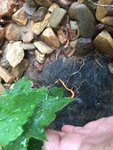
With more careful work we were able to successfully extract it from the soil!
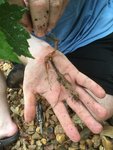
A few minutes later, it was potted comfortably and well-watered.
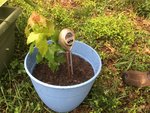 -SMALL NOTE-
-SMALL NOTE-
The pH reading across this, and all watered pots was at least 7.5, probably closer to 8 or more. It was watered from a hose this time, rather than RO water from the indoors. While it does sound like these guys are more tolerant of alkaline soil than other species, definitely want to get that pH down towards 6.5-7 over time - any recommendations from other explorers of the tiny forest?
Next up on the docket:
==THE MYSTERY BUSH==
At long last, the question was to be answered: one tree with two trunks or two trees with one trunk each? It wasn't immediately evident on clearing away the rocks.
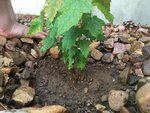
So we applied the same soil moistening & multitool application to clear away some of the ground cloth, revealing that it was likely two trees entwined around one another. This became more apparent once they were extracted from the ground.
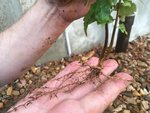
However, at a very slight force, they unhooked from one another to reveal that it was definitively two trees.
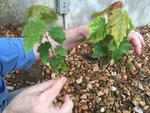
With some most impressive root symmetry, to boot.
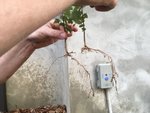
Not long afterwards, they were also comfortably potted & watered, and the forest grew to three.

Now we decided to grab some smaller seedlings as well, in the name of SCIENCE and having a few more in case disaster strikes.
==MIXED SMALL SEEDLINGS==
When grabbing the tall upright one, we'd also grabbed a tiny little guy nearby that was easier to pull due to a smaller root system. Pretty nondescript & out of attachments, so no pictures here.
After the main seedlings were done, we went around looking for other small ones of interest. Down in the front we discovered a detailed one with a branching trunk that was still quite small! A few minutes later, it was liberated from the river rock.
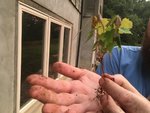
Finally, we looked for one in the front, and found what was by far the longest of the lot; it was in a section of deep river rocks and was basically *all trunk* - though admittedly a very thin one - with a tiny grouping of leaves at the top. They were soon all together & well-watered in the long pot.
The light was fading fast, we were weary, and the local wren families were more than a little ticked off we were keeping them awake by milling around near their nest, so we were pretty eager to get inside afterwards. No pictures of the final potting setup or the super-long one here, I'm out of attachments - whoops!
==NEXT STEPS==
Tomorrow, hopefully, we'll get one of the bigger pots set up & transplant the truly massive multi-branched one that caught my eye in the most recent post w/ pics. Will also be grabbing the fertiliser Kanorin recommended (TYVM for helping point me in the right direction here!) and probably some basic tools, if we can find 'em. After that, it's just a matter of patience & hoping they survive.
Status updates to continue in the coming weeks, hopefully stretching into the coming months & years.
==POSTAL NOTE==
@Kanorin Your forests are looking beautiful so far! The little guys on our property are definitely the spitting image of yours, albiet with slightly more angular & pointy leaves - which could very well be a minor genome difference or quirk of their age for all I know. In any case, brings me joy & comfort to see other little Acer Rubrums on the road to becoming part of the tiny forest










